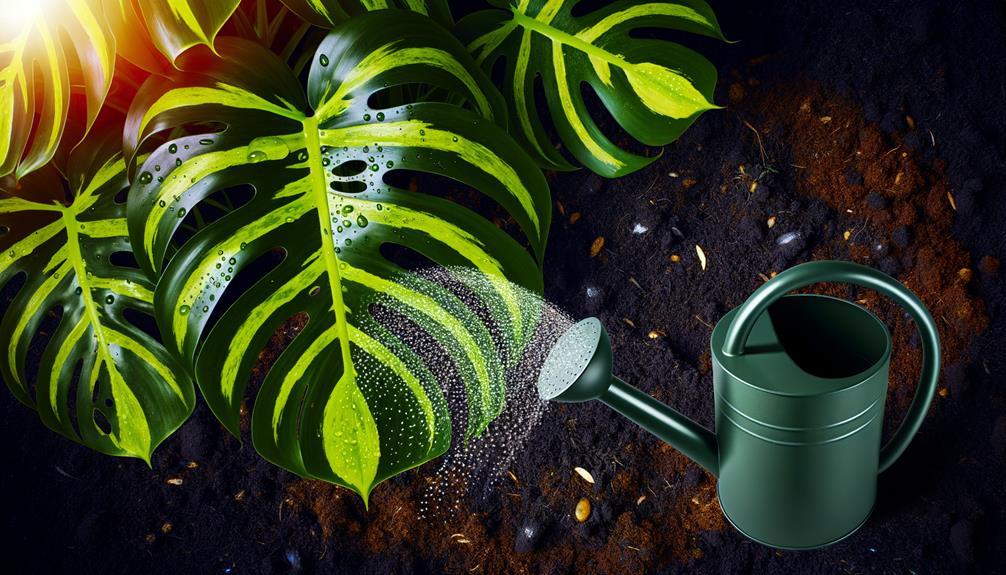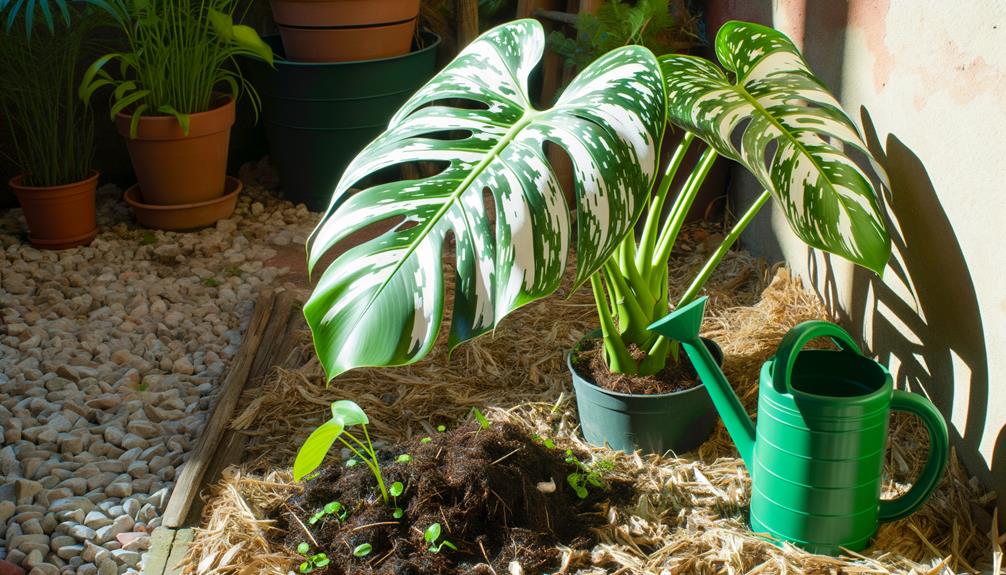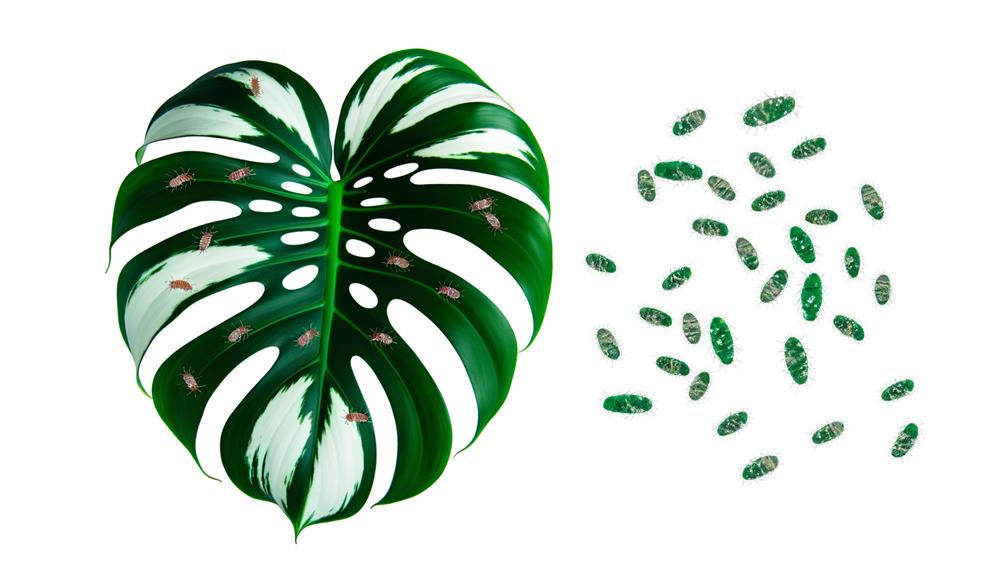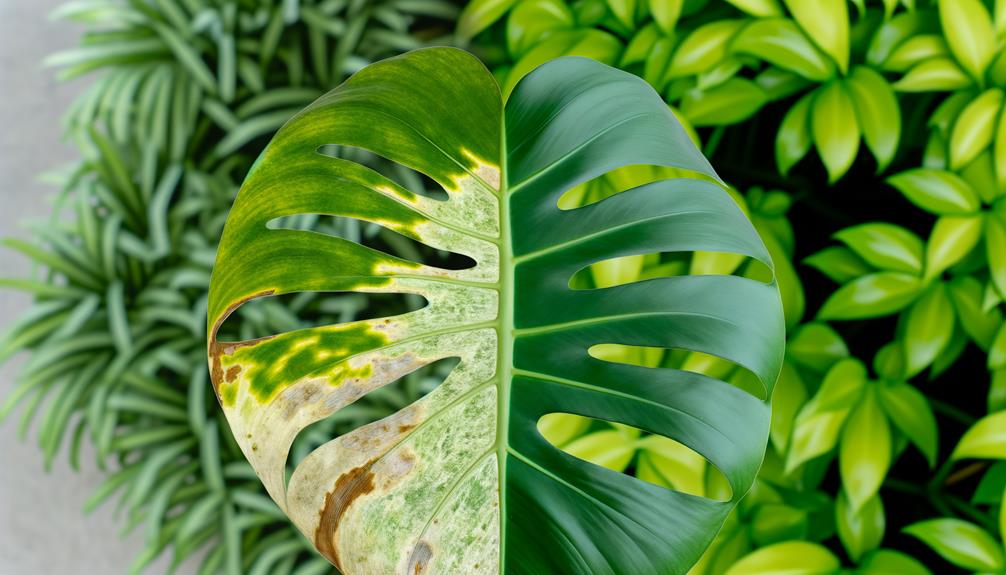Half Moon Variegated Monstera Deliciosa
The Half Moon Variegated Monstera Deliciosa is a striking plant originating from Central and South America, known for its green and white variegated leaves due to a unique genetic mutation. It thrives in humid, shaded environments with well-draining soil.
Best care involves providing bright, indirect light, maintaining humidity levels between 60-80%, and keeping temperatures between 65-80°F. Soil should be well-balanced with peat moss, perlite, and orchid bark, with a pH of 5.5 to 7.0.
Consistent moisture is essential, but avoid waterlogging. This plant often faces pests like spider mites and mealybugs, necessitating vigilance.
Further exploration will enhance your understanding.

Key Takeaways
- Originates from Central and South America, intertwined with indigenous cultures.
- Unique foliage patterns due to a genetic mutation.
- Thrives in bright, indirect sunlight and high humidity of 60-80%.
- Requires well-draining soil with peat moss, perlite, and orchid bark.
- Susceptible to pests like spider mites and mealybugs; early treatment is crucial.
Origins and History

Originating from the tropical rainforests of Central and South America, the variegated Monstera deliciosa has a rich history deeply intertwined with indigenous cultures and botanical exploration. Indigenous peoples revered the plant for its unique foliage and potential medicinal properties.
European explorers, intrigued by its striking appearance, introduced it to botanical gardens, where it gained popularity. The plant thrives in humid, shaded environments with well-draining soil, mimicking its natural habitat. Regular misting and maintaining temperatures between 65-85°F are essential for best growth.
Care involves providing indirect light and ensuring consistent moisture without waterlogging. The variegated Monstera deliciosa has since become a prized specimen in horticultural collections, symbolizing the intersection of natural beauty and meticulous care practices.
Unique Characteristics
The variegated Monstera deliciosa exhibits distinctive leaf patterns characterized by irregular patches of creamy white or yellow alongside the typical green foliage.
These color variations, caused by a genetic mutation, result in a stunning mosaic that requires careful light management to prevent leaf burn.
Proper care includes providing bright, indirect light and maintaining consistent humidity to support the plant's unique photosynthetic needs.
Distinctive Leaf Patterns
Characterized by their striking white and green marbled foliage, variegated Monstera deliciosa leaves exhibit a unique pattern that results from a genetic mutation affecting chlorophyll distribution. This mutation leads to irregular patches of chlorophyll-lacking tissue, creating an aesthetically pleasing contrast.
The fenestrations, or natural leaf splits, add to the visual appeal and are more pronounced in mature leaves. To maintain these distinct patterns, it is important to provide bright, indirect light, which supports best photosynthesis in the green sections while preventing the white areas from scorching.
Additionally, consistent humidity and well-draining soil are necessary to prevent root rot and promote healthy growth. Adequate care ensures that the variegation remains stable and the plant thrives.
Color Variations
Exhibiting a spectrum of variegation patterns, Monstera deliciosa can present hues ranging from creamy white to pale yellow, each influenced by environmental factors and genetic variance. These unique color variations are often the result of chlorophyll reduction, which affects photosynthesis and plant vigor. Variegation patterns can be classified into several categories, each requiring particular care to maintain their aesthetic appeal and health. Below is a table illustrating the primary types of variegation and their care requirements:
| Variegation Type | Description | Care Instructions |
|---|---|---|
| Albo | White variegation patches | Moderate light, avoid direct sunlight |
| Aurea | Yellow variegation patches | Bright, indirect light, consistent watering |
| Mint | Light green variegation | Filtered light, high humidity |
| Thai Constellation | Speckled white variegation | Bright, indirect light, balanced fertilization |
Understanding these variations and their specific needs ensures optimal growth and preservation of variegated Monstera deliciosa.
Ideal Growing Conditions

To thrive, Variegated Monstera Deliciosa requires bright, indirect sunlight, high humidity, and well-draining soil. Best light conditions range from 10,000 to 20,000 lux, mimicking the dappled light of its tropical rainforest habitat.
Humidity levels should be maintained between 60-80% to replicate its native environment, preventing leaf browning and promoting lush growth. Temperature preferences are between 65-80°F (18-27°C).
To promote ideal growth, consider the following:
- Light: Position near east-facing windows or use sheer curtains to diffuse direct sunlight.
- Humidity: Employ a humidifier or place a water tray nearby to maintain adequate moisture levels.
- Temperature: Avoid placing near drafts or sudden temperature changes, ensuring a stable climate.
Following these conditions supports healthy development and variegation.
Soil and Potting Mix
In addition to perfect light, humidity, and temperature conditions, Variegated Monstera Deliciosa requires a well-balanced soil and potting mix to guarantee proper drainage and nutrient availability. A mixture high in organic matter, such as peat moss or coco coir, combined with perlite or orchid bark, is recommended to mimic the plant's natural tropical habitat.
| Component | Function |
|---|---|
| Peat Moss/Coco Coir | Retains moisture and nutrients |
| Perlite | Enhances drainage and aeration |
| Orchid Bark | Provides structural support |
| Compost | Supplies essential nutrients |
The perfect pH for the soil should range between 5.5 and 7.0 to ensure nutrient uptake. Regularly checking and adjusting the soil composition is essential for optimal plant health.
Watering Needs

Maintaining ideal moisture levels is essential for the health of Variegated Monstera Deliciosa, which requires a consistently moist but not waterlogged substrate. Overwatering poses significant risks, including root rot and fungal infections, necessitating careful monitoring of soil moisture.
Employing a well-draining potting mix and ensuring proper drainage can mitigate these risks.
Ideal Moisture Levels
Ensuring ideal moisture levels for Variegated Monstera deliciosa involves striking a balance that prevents both water stress and root rot. This plant thrives in consistently moist but not waterlogged soil.
Key considerations include:
- Soil Type: Utilize a well-draining potting mix, typically incorporating perlite or orchid bark, to facilitate proper aeration and drainage.
- Watering Frequency: Water the plant when the top 2-3 inches of soil are dry to the touch, usually every 1-2 weeks, depending on environmental conditions.
- Humidity Requirements: Maintain ambient humidity levels between 60-80%, as this mimics the plant's native tropical habitat and supports healthy foliage.
Overwatering Risks
Overwatering Variegated Monstera deliciosa can lead to root rot, a condition characterized by the decay of root tissues due to prolonged exposure to excessive moisture. This condition inhibits the plant's ability to absorb nutrients and water, ultimately leading to stunted growth and foliar discoloration.
To mitigate overwatering risks, it is essential to allow the top inch of soil to dry out between waterings. Utilize a well-draining potting mix, such as one containing perlite or orchid bark, to enhance aeration. Additionally, make sure the pot has drainage holes to prevent water accumulation.
Monitoring the moisture level with a hydrometer can provide precise data, aiding in the maintenance of best hydration levels for the Variegated Monstera deliciosa.
Light Requirements
The variegated Monstera deliciosa thrives best in bright, indirect light, as direct sunlight can scorch its leaves while insufficient light may hinder its growth and variegation. Best light conditions are essential for maintaining the plant's characteristic split leaves and vibrant white-green pattern.
For top care:
- Positioning: Place near an east or west-facing window to guarantee ample indirect light.
- Light Duration: Aim for 6-8 hours of indirect light daily to promote photosynthesis.
- Artificial Lighting: In low-light environments, use grow lights to supplement natural light, ensuring a full spectrum to mimic sunlight.
Understanding these light requirements guarantees the variegated Monstera deliciosa remains healthy and visually striking, enhancing its ornamental value.
Fertilization Tips

For best growth, the Variegated Monstera Deliciosa requires a balanced nutrient regimen, with a specific focus on nitrogen, phosphorus, and potassium.
Follow a seasonal fertilization schedule to match the plant's natural growth cycles, using a high-grade, water-soluble fertilizer every two weeks during the active growing season and decreasing frequency during dormancy periods.
Monitoring and adjusting nutrient levels according to the plant's reaction will guarantee lush foliage and overall health.
Optimal Nutrient Balance
Achieving an ideal nutrient balance for variegated Monstera deliciosa necessitates a carefully calibrated fertilization regimen, tailored to the plant's unique needs. This involves understanding the specific macronutrient and micronutrient requirements that support peak growth and variegation.
Essential elements include:
- Nitrogen (N): Promotes lush, green foliage and overall plant vigor, essential for photosynthesis and growth.
- Phosphorus (P): Crucial for root development and flowering, enhancing the plant's structural integrity and energy transfer.
- Potassium (K): Supports water regulation, disease resistance, and enzyme activity, vital for overall health.
A balanced, water-soluble fertilizer with a ratio of 20-20-20 is recommended, applied at half strength to avoid nutrient burn. Regular monitoring and adjustments guarantee the plant receives the precise nutrient composition it requires.
Seasonal Fertilization Schedule
Understanding the seasonal fertilization schedule for variegated Monstera deliciosa is crucial to guarantee ideal nutrient uptake and sustained variegation throughout the year.
During the active growing season, typically from spring to early autumn, a balanced, water-soluble fertilizer with an N-P-K ratio of 20-20-20 should be applied biweekly. This ensures best foliar and root development.
In contrast, during dormancy in late autumn and winter, reduce fertilization frequency to once every six to eight weeks, using a diluted solution to prevent nutrient buildup. Additionally, micronutrients such as magnesium and calcium should be supplemented periodically to avoid deficiencies.
Maintaining this seasonal regimen will enhance the plant's variegated patterns and overall health, promoting robust growth and aesthetic appeal.
Pruning Techniques
Regularly trimming a Variegated Monstera Deliciosa is crucial for maintaining its health, promoting new growth, and ensuring its variegated pattern remains vibrant. Trimming involves the strategic removal of leaves, stems, and roots to optimize the plant's overall strength.
Key techniques include:
- Sterilization: Always sterilize pruning tools with isopropyl alcohol to prevent pathogen transmission.
- Selective Cutting: Focus on removing damaged, diseased, or overly crowded foliage to enhance airflow and light penetration.
- Node Trimming: Cut just above a node, where new growth emerges, to encourage denser and more robust development.
Regular monitoring and timely trimming not only prevent potential issues but also sustain the aesthetic appeal of this unique plant species.
Common Pests

Despite its resilience, the Variegated Monstera Deliciosa is susceptible to several common pests, including spider mites, scale insects, and mealybugs, which can greatly affect its health and variegation.
Spider mites, typically found on the undersides of leaves, cause stippling and webbing, leading to chlorosis. Scale insects adhere to stems and leaves, excreting honeydew that promotes sooty mold growth. Mealybugs, characterized by their cotton-like appearance, feed on plant sap, resulting in leaf yellowing and stunted growth.
Early detection and treatment are essential. Regularly inspect the plant and use insecticidal soap or neem oil for infestation control. Additionally, maintaining ideal humidity and cleanliness can prevent pest proliferation, ensuring the Monstera remains vibrant and healthy.
Propagation Methods
To secure the continued health and vibrance of the Variegated Monstera Deliciosa, propagation through methods such as stem cuttings and air layering can be highly effective.
Stem cuttings involve severing a healthy section with at least one node, then placing it in water or moist soil to root.
Air layering, by contrast, entails:
- Wounding the stem: Expose the inner tissue by making a shallow incision.
- Applying rooting hormone: This speeds up root development.
- Enclosing with moist sphagnum moss: Wrap the injured area and cover it with plastic to maintain humidity.
Both methods demand careful monitoring of moisture levels and light conditions to ensure successful root formation. Proper propagation not only maintains genetic fidelity but also contributes to the plant's longevity and aesthetic appeal.
Troubleshooting Issues

Identifying and addressing common issues such as leaf discoloration, pest infestations, and root rot are essential for maintaining the health of the Variegated Monstera Deliciosa. Leaf discoloration can indicate nutrient deficiencies or improper light exposure. Pest infestations, including spider mites and aphids, require immediate treatment with insecticidal soap or neem oil. Root rot is typically caused by overwatering and poor drainage. Ensuring well-draining soil and appropriate watering schedules is vital.
| Issue | Symptoms | Solutions |
|---|---|---|
| Leaf Discoloration | Yellowing or browning leaves | Adjust light exposure, fertilize properly |
| Pest Infestations | Visible insects, webbing | Apply insecticidal soap, neem oil |
| Root Rot | Mushy roots, wilting leaves | Improve drainage, reduce watering |
Benefits of Ownership
One of the primary benefits of owning a Variegated Monstera Deliciosa is its ability to greatly enhance indoor air quality through its natural air-purifying properties. This plant's broad, fenestrated leaves facilitate gas exchange, effectively removing toxins such as formaldehyde and benzene from indoor environments.
Additionally, owning this aesthetically pleasing plant offers further advantages:
- Aesthetic Appeal: The unique variegation creates a striking visual focal point in any room.
- Psychological Benefits: Interaction with indoor plants is scientifically proven to reduce stress and enhance mood.
- Humidity Regulation: The Monstera Deliciosa releases moisture through transpiration, helping to maintain ideal indoor humidity levels.
Proper care includes indirect light, well-draining soil, and consistent watering to maintain its health and vigor.
Conclusion
To wrap up, the Half Moon Variegated Monstera Deliciosa offers a distinctive and visually impressive addition to plant collections. It requires specific care conditions such as ideal light, well-draining soil, and precise watering.
Successful pest control and propagation methods are crucial for maintaining the plant's durability and well-being. Similar to a finely-tuned mechanism, every element of its care enhances its overall health and visual charm, establishing it as a valued specimen for both beginner and experienced gardeners.






